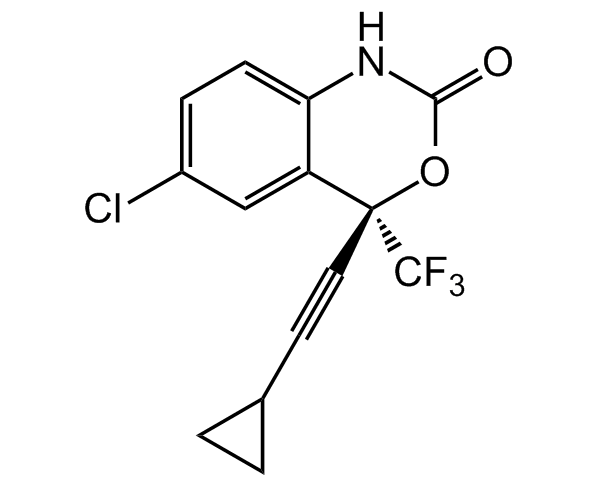Efavirenz
| Code | Size | Price |
|---|
| AG-CR1-3751-M010 | 10 mg | £50.00 |
Quantity:
| AG-CR1-3751-M050 | 50 mg | £110.00 |
Quantity:
| AG-CR1-3751-M250 | 250 mg | £260.00 |
Quantity:
Prices exclude any Taxes / VAT
Overview
Regulatory Status: RUO
Shipping:
AMBIENT
Storage:
Short Term: +4°C, Long Term: -20°C
Images
Documents
Further Information
Alternate Names/Synonyms:
DMP 266; EFV; L-743,726
Appearance:
White to off-white solid.
CAS:
154598-52-4
Class:
9
EClass:
32160000
Form (Short):
liquid
GHS Symbol:
GHS07,GHS08,GHS09
Handling Advice:
Keep cool and dry.
Hazards:
H302, H319, H360, H372, H410
InChi:
InChI=1S/C14H9ClF3NO2/c15-9-3-4-11-10(7-9)13(14(16,17)18,21-12(20)19-11)6-5-8-1-2-8/h3-4,7-8H,1-2H2,(H,19,20)
InChiKey:
XPOQHMRABVBWPR-UHFFFAOYSA-N
Long Description:
Chemical. CAS: 154598-52-4. Formula: C14H9ClF3NO2. MW: 315.7. Efavirenz is a non-nucleoside reverse transcriptase inhibitor (NNRTI) that exhibits antiviral and anticancer activities. Efavirenz binds to wild-type and mutant HIV-1 RTs (Ki= 2.93nM and 3.85-56.5nM, respectively). It inhibits wild-type and mutant HIV-1 viral replication in MT-4 human T lymphoid cells (IC95s = 1.5-1,500 nM). Efavirenz also prevents RNA plus-strand initiation with an IC50 value of 17nM. Efavirenz is an anti-HIV drug, commonly used in combination therapy for AIDS treatment. It is part of highly active antiretroviral therapy (HAART) for the treatment of a human immunodeficiency virus (HIV) type 1. In various cancer cell lines, Efavirenz inhibits cellular proliferation and increases activation of p53. CARD8 inflammasome senses HIV-1 protease activity. In HIV1-infected cells, CARD8 cannot detect the virus because the viral protease remains inactive as a subunit of unprocessed Gag-Pol polyprotein. HIV-1-specific non-nucleoside reverse transcriptase inhibitors (NNRTIs), such us Efavirenz, can trigger CARD8 sensing because they bind to HIV-1 Pol and enhance intracellular Gag-Pol polyprotein dimerization, which causes premature viral protease activation. Treating HIV-1-infected macrophages and CD4+ T cells with NNRTIs leads to CARD8-mediated caspase-1 activation and pyroptotic cell death. Induction of the CARD8 inflammasome activation has led to rapid clearance of latent HIV-1 in patient CD4+ T cells after virus reactivation.
MDL:
MFCD05662344
Molecular Formula:
C14H9ClF3NO2
Molecular Weight:
315.7
Package Type:
Vial
PG:
III
Precautions:
P260, P273, P280, P301+312, P305+P351+P338, P308+P313, P391, P501
Product Description:
Efavirenz is a non-nucleoside reverse transcriptase inhibitor (NNRTI) that exhibits antiviral and anticancer activities. Efavirenz binds to wild-type and mutant HIV-1 RTs (Ki= 2.93nM and 3.85-56.5nM, respectively). It inhibits wild-type and mutant HIV-1 viral replication in MT-4 human T lymphoid cells (IC95s = 1.5-1,500 nM). Efavirenz also prevents RNA plus-strand initiation with an IC50 value of 17nM. Efavirenz is an anti-HIV drug, commonly used in combination therapy for AIDS treatment. It is part of highly active antiretroviral therapy (HAART) for the treatment of a human immunodeficiency virus (HIV) type 1. In various cancer cell lines, Efavirenz inhibits cellular proliferation and increases activation of p53. CARD8 inflammasome senses HIV-1 protease activity. In HIV-infected cells, CARD8 cannot detect the virus because the viral protease remains inactive as a subunit of unprocessed Gag-Pol polyprotein. HIV-1-specific non-nucleoside reverse transcriptase inhibitors (NNRTIs), such us Efavirenz, can trigger CARD8 sensing because they bind to HIV-1 Pol and enhance intracellular Gag-Pol polyprotein dimerization, which causes premature viral protease activation. Treating HIV-1-infected macrophages and CD4+ T cells with NNRTIs leads to CARD8-mediated caspase-1 activation and pyroptotic cell death. Induction of the CARD8 inflammasome activation has led to rapid clearance of latent HIV-1 in patient CD4+ T cells after virus reactivation.
Purity:
>98% (HPLC)
Signal word:
Danger
SMILES:
ClC1=CC=C2C([C@@](C#CC3CC3)(C(F)(F)F)OC(N2)=O)=C1
Solubility Chemicals:
Soluble in DMSO (25mg/ml), DMF (20mg/ml) or ethanol (10mg/ml). Insoluble in water.
Transportation:
Non-hazardous
UN Nummer:
3077
UNSPSC Category:
Biochemical Reagents
UNSPSC Number:
12352200
Use & Stability:
Stable for at least 2 years after receipt when stored at -20°C.
References
L-743,726 (DMP-266): A novel, highly potent nonnucleoside inhibitor of the human immunodeficiency virus type 1 reverse transcriptase: S.D. Young, et al.; Antimicrob. Agents Chemother. 39, 2602 (1995) | The nonnucleoside reverse transcriptase inhibitors efavirenz and nevirapine in the treatment of HIV: M. Sheran; HIV Clin. Trials 6, 158 (2005) | HIV-susceptible transgenic rats allow rapid preclinical testing of antiviral compounds targeting virus entry or reverse transcription: C. Goffinet, et al.; PNAS 104, 1015 (2007) | HIV-1 reverse transcriptase plus-strand initiation exhibits preferential sensitivity to non-nucleoside reverse transcriptase inhibitors in vitro: J.A. Grobler, et al.; J. Biol. Chem. 282, 8005 (2007) | Efavirenz in the therapy of HIV infection: N.Y. Rakhmanina & J.N. van den Anker; Expert Opin. Drug Metab. Toxicol. 6, 95 (2010) | Cytotoxic effect of efavirenz is selective against cancer cells and associated with the cannabinoid system: M. Hecht, et al.; AIDS 27, 2031 (2013) | Efavirenz induces neuronal autophagy and mitochondrial alterations: P.R. Purnell & H.S. Fox; J. Pharmacol. Exp. Ther. 351, 250 (2014) | Mechanism of allosteric inhibition of HIV-1 reverse transcriptase revealed by single-molecule and ensemble fluorescence: G.D. Schauer, et al.; Nucleic Acids Res. 42, 11687 (2015) | CARD8 is an inflammasome sensor for HIV-1 protease activity: Q. Wang, et al.; Science 371, 6535 (2021)



